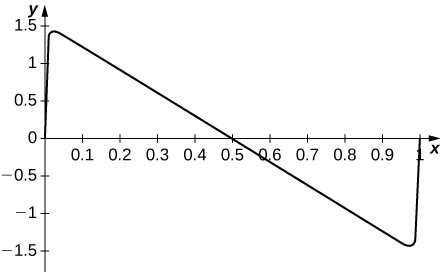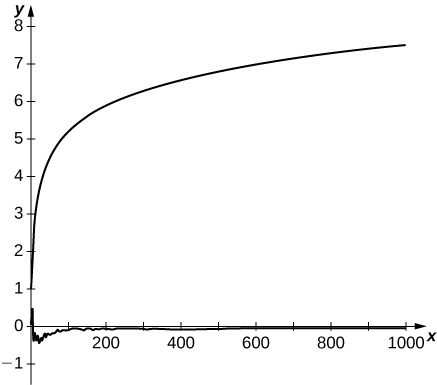9.5E: Exercises for Section 9.5
( \newcommand{\kernel}{\mathrm{null}\,}\)
In exercises 1 - 30, state whether each of the following series converges absolutely, conditionally, or not at all.
1)
2)
- Answer
- This series diverges by the divergence test. Terms do not tend to zero.
3)
4)
- Answer
- Converges conditionally by alternating series test, since
5)
6)
- Answer
- Converges absolutely by limit comparison to
7)
8)
- Answer
- Diverges by divergence test since
9)
10)
- Answer
- Diverges by the divergence test, since its terms do not tend to zero. The limit of the sequence of its terms does not exist.
11)
12)
- Answer
13)
14)
- Answer
- Converges by alternating series test.
15)
16)
- Answer
- Converges conditionally by alternating series test. Does not converge absolutely by limit comparison with
Solution:
17)
18)
- Answer
- Diverges; terms do not tend to zero.
19)
20)
- Answer
- Converges by alternating series test. Does not converge absolutely by limit comparison with harmonic series.
21)
22)
- Answer
- Converges absolutely by limit comparison with
23)
24)
- Answer
- Converges by alternating series test since
25)
26)
- Answer
- Converges absolutely, since
27)
28)
- Answer
- Terms do not tend to zero. Series diverges by divergence test.
29)
30)
- Answer
- Converges by alternating series test. Does not converge absolutely by limit comparison with harmonic series.
In exercises 31 - 36, use the estimate
31) [T]
32) [T]
- Answer
33) [T]
34) [T]
- Answer
35) [T]
36) [T]
- Answer
For exercises 37 - 45, indicate whether each of the following statements is true or false. If the statement is false, provide an example in which it is false.
37) If
38) If
- Answer
- True.
39) If
40) If
- Answer
- True.
41) If
42) Let
- Answer
- True. If one converges, then so must the other, implying absolute convergence.
43) Suppose that
44) Suppose that
45) Suppose that
- Answer
- Yes. Take
In exercises 46 - 49, the series do not satisfy the hypotheses of the alternating series test as stated. In each case, state which hypothesis is not satisfied. State whether the series converges absolutely.
46)
47)
- Answer
- Not decreasing. Does not converge absolutely.
48)
49)
- Answer
- Not alternating. Can be expressed as
50) Show that the alternating series
51) Suppose that
- Answer
- Let
52) Show that the alternating series
53) The formula
- Answer
- For
54) The formula
55) How many terms in
- Answer
- Let
56) How many terms in
57) Sometimes the alternating series
- Answer
- Let
The alternating series in exercises 58 & 59 converge to given multiples of
58) [T]
59) [T]
- Answer
60) [T] The series
61) [T] If
- Answer
62) [T] Plot the series
63) [T] Plot the series
- Answer
-
The series jumps rapidly near the endpoints. For

64) [T] Plot the series
65) [T] The alternating harmonic series converges because of cancelation among its terms. Its sum is known because the cancelation can be described explicitly. A random harmonic series is one of the form
- Answer
-
Here is a typical result. The top curve consists of partial sums of the harmonic series. The bottom curve plots partial sums of a random harmonic series.

66) [T] Estimates of
67) [T] The Euler transform rewrites
- Answer
- By the alternating series test,
68) [T] In the text it was stated that a conditionally convergent series can be rearranged to converge to any number. Here is a slightly simpler, but similar, fact. If
a. Recursively define
b. Explain why eventually
c. Explain why this implies that


